By Art Toalston
Contributing Writer, B&R
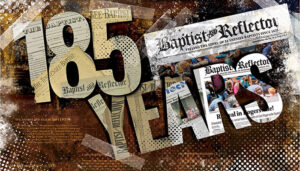 FRANKLIN — R.G.B. Howell started a newspaper within a month after moving to Tennessee in January 1835.
FRANKLIN — R.G.B. Howell started a newspaper within a month after moving to Tennessee in January 1835.
He called it The Baptist — forerunner 185 years ago to the Baptist and Reflector.
“To unite, harmonize, and invigorate the church in this state,” Howell wrote in launching the paper, “some medium of communication is necessary, through which our brethren, in its various parts, should have knowledge of each other, and reciprocally understand more extensively and distinctly their feelings, views and designs.”
With a sense of call to First Baptist Church in Nashville in the frontier west, Howell became the leading proponent among Baptists in the state for joining together in the missions enterprise, reflecting the vision cast two decades earlier by Luther Rice, a key founder in Philadelphia of the Triennial Convention.
In addition to The Baptist, Howell quickly rose to a leadership role in the Tennessee Baptist Convention, which had been formed in 1833. He became its moderator in October 1835 and served until 1850. Howell was elected as the Southern Baptist Convention’s second president, presiding over meetings in 1851, 1853, 1855 and 1857.
During its first 82 years, The Baptist was led by Howell and just two successors, J.R. Graves and Edgar E. Folk. Graves, in contrast to Howell’s commitment to Baptist unity, contended that the church must not compromise its authority by embracing denominational movements.
Though Graves’ view held large sway, it never overpowered the Tennessee convention. Folk, who led the paper from 1889 until his death in 1917, was instrumental in establishing an editors’ fellowship, the Southern Baptist Press Association, in 1895 (now the Association of State Baptist Publications).
A courageous opponent of lynching, Folk wrote, “No paper in the South has spoken out more frequently or strongly in condemnation of lynching than have we.” And he sensed the importance of helping those struck by natural disasters, inviting an East Tennessee pastor after a deluge claimed some 20 lives along with homes, livestock and crops “to give our readers an account of the flood and whether the local Baptists will need assistance in any way.”
After a number of consolidations with other Baptist publications in Tennessee such as the Baptist Reflector, the paper became the Baptist and Reflector in 1889.
Finances and circulation were ongoing challenges for those who owned the paper over the years, with one editor, Murphy R. Cooper, selling his home to continue publishing. But, facing bankruptcy, he sold the Baptist and Reflector in less than a year to the Tennessee convention in 1921.
John D. Freeman, elected as B&R editor in 1925, heightened the paper’s content to reflect and support the TBC’s ministries and theological convictions. The state paper, he once wrote, is “the one regular medium through which to give information, to stress the study of doctrine and polity, and to set before all groups the various programs of activity upon which we must depend for our unity and efficiency in doing the Lord’s work.”
Freeman’s first “big assignment,” as he called it, was covering the Scopes Monkey Trial in June 1925. “To see modernism in action as the writer has seen it during the Dayton trial,” he wrote, “is to know its meanness, its shrewdness, its purpose, its goal … to rid American schools of the last influence of belief in the Bible as a supernatural revelation.”
“We may hope soon to see the modernists in Southern Baptist schools and pulpits coming into the open where God’s people will have a chance of meeting them face to face and of offsetting their pernicious influence upon the minds and hearts of growing children,” Freeman wrote.
Ongoing resolve to serve Tennessee Baptists was succinctly stated by Richard N. Owen, editor of the B&R from 1950 to 1968. “The Baptist and Reflector has been and will be a Baptist paper with an unashamed faith reflecting the light of our times in the light of the timeless,” he wrote. “Through it you should declare yourselves; for the Lord’s people dare not be dumb when truth must be expressed in word uttered or written.”
A longtime female TBC staff member, Eura Rich Lannom, served as acting editor from 1974-1976 prior to the election of Al Shackleford, who was the first journalist to lead the paper, adding to its strength by hiring another journalist as associate editor.
Shackleford also was the first editor to invite the convention’s executive director to write a regular column, and he gave extensive coverage to the TBC’s early partnership missions initiative in Burkina Faso in conjunction with the then Foreign Mission Board (now International Mission Board).
Shackleford’s successors also came with journalistic experience — Fletcher Allen, who wrote a 2005 history of the B&R titled “Telling the Truth in Love,” and current editor Lonnie Wilkey, who has continued to build the paper’s reputation for its wide-ranging coverage of key Baptist causes.
Marking, for example, the 25th anniversary of the convention’s disaster relief ministry, Wilkey wrote, “We have sent Tennessee Baptists all over the world, not for their personal glory, but to bring glory and honor to the One in whose name we minister, Jesus Christ. … We cannot rest on our laurels. Until Jesus returns, disasters will continue … and we must be ready to respond.”
BAPTIST AND REFLECTOR EDITORS
The B&R has had 16 editors in its 185-year history. Here’s a look at those who have “guided the ship.”
James Graves, 1848-89
Edgar Folk, 1889-1917
Albert Bond, 1917-1920
M.R. Cooper, 1920-21
Hight Moore, 1921
Jesse Moore, 1921-25
Oscar Bryan, 1925
Oury Wilburn Taylor, 1933-50
Richard Owen, 1950-68
James A Lester, 1968-73
Eura Lannom, 1974-76 (interim)
Alvin Shackleford, 1976-87
Wm Fletcher Allen, 1987-98
Lonnie Wilkey, 1998-present
MARCHING THROUGH NEARLY TWO CENTURIES OF COVERAGE, COLUMNS, CALLINGS
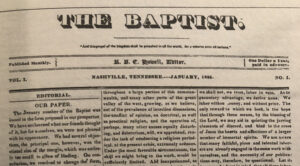
The Baptist
1835 – The first issue of THE BAPTIST, the forerunner of the Baptist and Reflector, is published by editor R.C.B. Howell in Nashville.
1848 – James Robinson Graves becomes the second editor of the Baptist and Reflector. He is perhaps best known for his connection with Landmarkism, a movement based on the premise that Baptist churches are the only true churches. His tenure as editor lasts until 1889.
1889 – THE BAPTIST merges with the American Baptist Reflector of Chattanooga to become the Baptist and Reflector. Edgar E. Folk became the third editor of the Baptist and Reflector and was the first native Tennessean to hold the position.
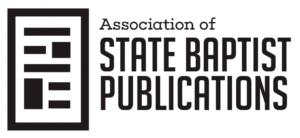 1895 – Edgar E. Folk brings other state paper editors together to form the Southern Baptist Press Association, which still exists today as the Association of State Baptist Publications.
1895 – Edgar E. Folk brings other state paper editors together to form the Southern Baptist Press Association, which still exists today as the Association of State Baptist Publications.
1921 – The Tennessee Baptist Convention purchases the Baptist and Reflector.
1925 — The B&R, under the leadership of editor John D. Freeman, provides in-depth coverage of “the Scopes trial” that was held in Dayton, Tennessee. The trial revolved around the inclusion of evolution being taught in public schools.
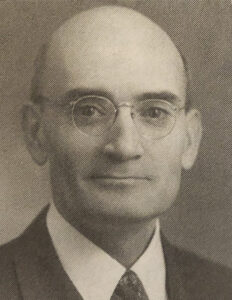
Oury Wilburn Taylor
1935 — Baptist and Reflector editor Oury Wilburn Taylor celebrates the paper’s 100-year anniversary by publishing a 64-page edition of the B&R that recognized, as he put it, “100 years of service to our people.”
1950 — Richard N. Owen begins his 18-year stint as editor of the B&R and helps guide the paper through a time of financial hardships.
1974 – Eura Lannom becomes the first female to serve as interim editor of the Baptist and Reflector.
1998 — Current B&R editor Lonnie Wilkey begins his tenure as editor of the paper. Wilkey, who had served as associate editor for the previous 10 years, has routinely won awards for his writing — both for news coverage and editorials — throughout his career with the paper.
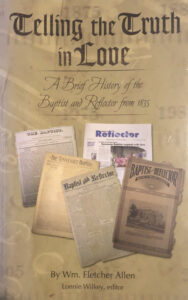 2003 — The B&R recognizes and honors Tennessee Baptist Disaster Relief for 25 years of service in Tennessee, across the nation and around the world.
2003 — The B&R recognizes and honors Tennessee Baptist Disaster Relief for 25 years of service in Tennessee, across the nation and around the world.
2005 — Telling the Truth in Love — a book that chronicles the history of the B&R — is written by Wm. Fletcher Allen. Current B&R editor Lonnie Wilkey, who edited the book, said it was a “labor of love”
for Allen.
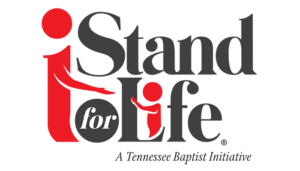 2015 — The Baptist and Reflector’s homepage, baptistandreflector.org, is launched with its own URL. For the previous 17 years, dating back to its original launch in 1998, the B&R webpage had been “housed” on the TBMB page.
2015 — The Baptist and Reflector’s homepage, baptistandreflector.org, is launched with its own URL. For the previous 17 years, dating back to its original launch in 1998, the B&R webpage had been “housed” on the TBMB page.
2019 — The B&R plays a crucial role in the promotion of the “I Stand for Life” campaign and provides coverage of TBMB president and executive director Randy C. Davis’ appearance before the state’s Senate subcommittee.
